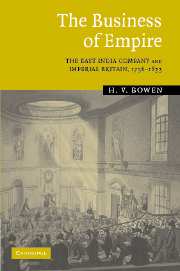Book contents
- Frontmatter
- Contents
- List of figures
- List of tables
- Preface
- Notes on the text
- List of abbreviations and short titles
- 1 Introduction
- 2 Relationships: city, state, and empire
- 3 Relationships: government and the Company
- 4 People: investors in empire
- 5 People: Company men
- 6 Methods: an empire in writing
- 7 Methods: the government of empire
- 8 Methods: the management of trade
- 9 Influences: the Company and the British economy
- Afterword
- Index
6 - Methods: an empire in writing
Published online by Cambridge University Press: 09 July 2009
- Frontmatter
- Contents
- List of figures
- List of tables
- Preface
- Notes on the text
- List of abbreviations and short titles
- 1 Introduction
- 2 Relationships: city, state, and empire
- 3 Relationships: government and the Company
- 4 People: investors in empire
- 5 People: Company men
- 6 Methods: an empire in writing
- 7 Methods: the government of empire
- 8 Methods: the management of trade
- 9 Influences: the Company and the British economy
- Afterword
- Index
Summary
The fact that the directors, officials, and clerks of the East India Company spent much of their time reading, preparing, or copying lengthy documents underlines the central importance of written communication to the domestic management of the Company's overseas affairs. The significance of this cannot be overstated because exchanges of despatches between Britain and Asia formed the basis of long-distance working relationships between men who sometimes had never set eyes on one another. Despatches contained instructions and orders but, just as importantly, they provided a means by which those in Britain could form a view of events and developments in the East. Yet, of course, the realities of distance and the speed of communication meant that those at East India House could never be in possession of up-to-date news about their overseas territories and settlements. The problem of asymmetric information, or a situation in which the directors always knew considerably less about the prevailing state of overseas affairs than did their employees in Asia, was ever-present during this period and offered a considerable obstacle to the effective management of the Company. But, having accepted that their view of the East would always be at least several months out of date, the Company's directors and senior managers nevertheless dedicated themselves to the establishment of a full and accurate picture of events in Asia.
The occupants of East India House also increasingly sought better knowledge of the societies, cultures, and economies being brought under Company control in India.
- Type
- Chapter
- Information
- The Business of EmpireThe East India Company and Imperial Britain, 1756–1833, pp. 151 - 181Publisher: Cambridge University PressPrint publication year: 2005

